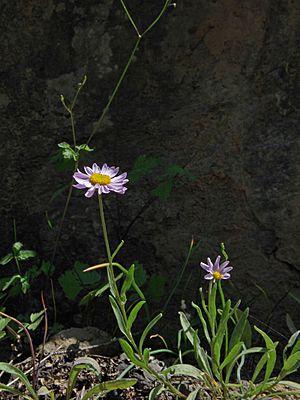Mad River fleabane facts for kids
Quick facts for kids Mad River fleabane |
|
|---|---|
 |
|
| Conservation status | |
| Scientific classification | |
| Genus: |
Erigeron
|
| Species: |
maniopotamicus
|
Erigeron maniopotamicus, also known as the Mad River fleabane, is a very rare flowering plant. It belongs to the aster family, which includes daisies and sunflowers. This plant is endemic, meaning it is found only in a specific area. For the Mad River fleabane, that area is northwestern California. It grows in just four known spots within Humboldt and Trinity Counties.
Contents
About the Mad River Fleabane
Where It Lives
The Mad River fleabane grows in open spaces. You can find it in forests, woodlands, and meadows. It prefers areas along the Mad River. These spots usually have rocky, tan-colored soil. The plant grows in places with little other plant cover. It is often found near serpentine soils, but it does not grow directly on them. Serpentine soils are special soils that come from certain rocks.
How It Was Discovered
Scientists officially described Erigeron maniopotamicus in 2004. They found a special plant, called a type specimen, on Board Camp Mountain. This mountain is in Humboldt County, California. The plant was named after the Mad River. Its scientific name, maniopotamicus, comes from Greek words. These words mean "mad river," using the British meaning of "mad," which is like "crazy" in American English.
What It Looks Like
The Mad River fleabane is a perennial herb. This means it is a plant that lives for more than two years. It grows from a taproot, which is a main root that grows straight down. It also has a caudex, a woody base near the ground.
Stems and Leaves
The plant's stem can grow up to 27 centimeters (about 11 inches) tall. It has rough hairs covering it. The leaves are also hairy and are lance-shaped, like the tip of a spear. They can be up to 10 centimeters (4 inches) long and 1.4 centimeters (0.6 inches) wide. Both the stem and leaves can be green or have a purple tint.
Flowers
The plant produces one or a few flower heads. A flower head is a cluster of many small flowers that look like one big flower. Each head has pointed phyllaries, which are like small leaves that protect the flower. These phyllaries are green with orange lines in the middle.
Each flower head has two types of tiny flowers:
- Ray florets: These are the petal-like parts around the edge. The Mad River fleabane can have up to 33 of these. They can be white, pink, or purple and are about 1 centimeter (0.4 inches) long.
- Disc florets: These are the small, yellow flowers in the center of the head. There are many of them.
Protecting This Rare Plant
The Mad River fleabane faces some challenges that could harm it. These include:
- Grazing by cattle: Animals eating the plants can prevent them from growing and reproducing.
- Logging: Cutting down trees in the area can destroy the plant's habitat.
- Activities related to logging: This includes building and maintaining roads, and sometimes dumping waste. These actions can also damage the places where the plant lives.
Protecting these few locations is important to help the Mad River fleabane survive.
Images for kids



